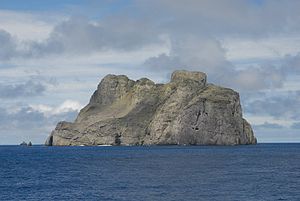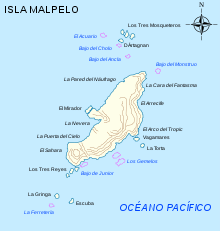Malpelo Island is in the Pacific Ocean 400 km west of Colombia. The island has been inscribed on the UNESCO World Heritage list. Some divers know it as "shark heaven."
Understand
[edit]
The only inhabitants on the island is the staff of a military outpost.
History
[edit]The island has been known about by Europeans since at least 1530. It’s unlikely that humans have ever inhabited it.
Landscape
[edit]Extremely rugged, to say the least.
Flora and fauna
[edit]Part of a solitary volcanic submarine ridge, Malpelo island looks like just another barren rock. Bird guano deposits, however, allow algae, lichens, mosses, shrubs and ferns grow on and around it.
The waters around the island are fantastic for shark diving. You may see swarms of hundreds of hammerhead and silky sharks and even the threatened smalltooth sand tiger.
Climate
[edit]Tropical, though “barren spit of rock” isn’t usually what the term conjures up.
Get in
[edit]Anyone hoping to visit Malpelo must get permission from the National Natural Park offices in Bogotá. Since the island is a Marine Park, the only way to visit it is via Liveaboard; the Malpelo Foundation allows one Liveaboard dive ship to be present at the island at a time, with a maximum of 25 divers. Anchoring is not allowed anywhere within the marine protected area.
The main port to travel to Malpelo is Buenaventura, and the trip by boat from Buenaventura takes between 30 and 40 hours (via Gorgona Island, also supposed to be a diver's paradise).
In 2018 it is not possible anymore for Panamanian boats to go directly to Malpelo. Colombia Dive Adventures[dead link] offers liveaboard dive trips from Buenaventura.
The easiest way to get to Malpelo might be with Coiba Dive Expeditions[dead link] in Panama City. Through them, a 11-day trip with 6 days of diving (2 days to Malpelo and 2 days back) starts at about US$4500 per person (May 2017). That does not include the $90/day park fee for diving, nor equipment rental (they prefer you bring your own gear). Of course they will deal with the bureaucracy for you.
Fees and permits
[edit]US$90/day park fee for divers on boat under Colombian flag (2017).
Get around
[edit]
See
[edit]Despite its seemingly lifeless appearance, the island is a wildlife haven. In addition to its renowned shark population, it is a designated Important Bird Area, and is home to a species of crab found nowhere else on Earth.
Do
[edit]The island is most famous as a diving location due to its amazing shark population.
Buy
[edit]It’s unlikely you’ll be buying anything here.
Eat
[edit]You are going to be bringing your own food. The island is a wildlife sanctuary so you won’t be hunting or fishing and there are no shops or restaurants.
Drink
[edit]There probably isn’t going to be any publicly available drinking water on the island.
Sleep
[edit]You'll sleep on your boat. There are no public lodgings on the island.
Go next
[edit]You’ll probably be traveling back to Buenaventura.

